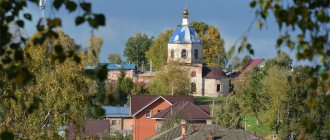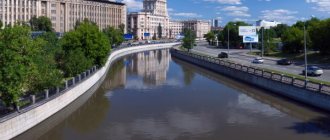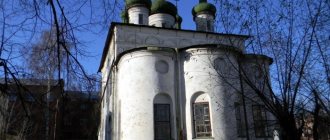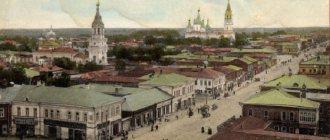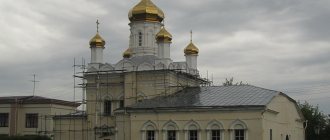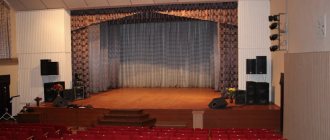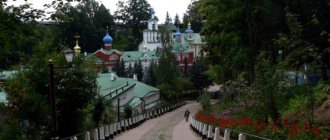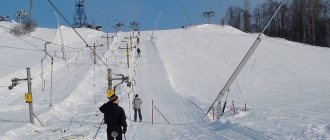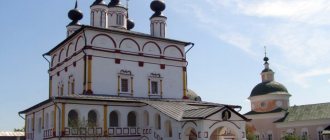One day in Gorodets is both a little and a lot. The city gives full impressions, but there is sorely not enough time to savor the atmosphere. Lately, Nina and I have only been able to go on short trips, which we used to call trips among ourselves. Having decided on a weekend trip to Nizhny Novgorod, we, unbeknownst to ourselves, divided even such a short outing into people into two parts: Gorodets and Nizhny Novgorod. At first I was skeptical about the idea of spending a day in Gorodets, but now I’m glad that I succumbed to persuasion - Nina will not give bad advice. Now I advise everyone, if possible, to visit the wonderful town of Gorodets, where every street greets you with carved bright houses, the smell of gingerbread and nice intimate museums. And Gorodets itself can well be called an open-air museum, on the banks of its native Volga.
Gorodets stands on the high bank of the Volga
Where is the city
Gorodets lies 53 km from Nizhny Novgorod, on the left bank of the Volga. There is a version that its neighbor, now a large regional center, got its name thanks to the modest Gorodets. Created a whole century later, it was located downstream of the river, which is why it became Nizhny. Gorodets coordinates: 56°39′01″ N. w. 43°28′13″ E. d.
The city has a cargo and passenger port, which during the navigation period receives dry cargo ships and excursion ships.
The main connection with populated areas is a highway, which is almost 1.5 times longer than the river route from Nizhny Novgorod and is 72 km. The roads are in good condition, so you can get there by car in just over an hour.
The bus will cover the same route in 2 hours 20 minutes, making frequent stops in different settlements. Regular buses depart from the Gorodets bus station with an average interval of 0.5 hours. The fare is 167 rubles.
Attractions in the surrounding area
Paraskeva Pyatnitsa Church
Address: Nizhny Novgorod region, Gorodetsky district, village. Kiryushino How to get there: by car 24 km from Gorodets to the village. Kiryushino (about 20 min.)
The temple was erected at the end of the 19th century from red brick. Now this church is not working and needs restoration, although the skeleton of the building has been preserved in almost untouched condition.
The period of prosperity of this temple occurred at the end of the century before last, when priest Pavel Alekseevich Gaginsky spent a lot of his own money on the church and even opened a Sunday school here.
After the October Revolution, the church stopped working and holding services. The temple is not active to this day.
Nizhegorodskaya HPP
Coordinates:
56°39'2″N 43°22'32″E
Address: Nizhny Novgorod region, Gorodetsky district, Volzhsko-Kama cascade, Zavolzhye How to get there: regular bus No. 101 Gorodets-Zavolzhye or by car 20 km from Gorodets to Zavolzhye (about 15 min.)
Not far from Gorodets on the Volga, on the territory of the Gorky Reservoir, the Nizhny Novgorod hydroelectric power station, built in 1951-52, is located, which is one of the oldest structures of this type in Russia. The station generates electricity with a capacity of 520 MW.
Next to the hydroelectric power station there is a dam with a total length of 18 and a half kilometers. The structure itself includes a two-level lock, three dams, seven earthen dams, one dam for draining water and the hydroelectric power station itself.
A highway passes through the hydroelectric dam, which connects two cities located on the opposite banks of the Volga - Zavolzhye and Gorodets.
Weather, best time to travel
The climate in the region is moderate continental, characterized by long, rather cold winters and short summers. In winter, the sky is often covered with clouds, the sun rarely appears; in the warm season, clear skies are observed in 50%. Spring comes in April; in the early days, positive air temperatures are established, which remain until the end of October.
Precipitation per year is 650 mm, half of the days a year are rainy. Snow cover begins in November and disappears completely by mid-April.
Daily air temperature (0C), amount of precipitation (mm) and sunny days by month:
| Jan. | Feb. | March | Apr. | May | June | July | Aug. | Sep. | Oct. | Nov. | Dec. |
| -8,5 | -6 | -1,5 | +8 | +19 | +21 | +25 | +23 | +16 | +6,5 | 0 | -4,5 |
| 25 | 23 | 17 | 22,5 | 26 | 33 | 36 | 24 | 26 | 32 | 25 | 28 |
| 1 | 0 | 3 | 9 | 20 | 17 | 21 | 25 | 14 | 7 | 4 | 0 |
According to the calculation of the comfort factor, the best months for a trip to Gorodets are the period from May to September, with a maximum score (5 points) in the months of June and August.
Famous townspeople
City residents are proud of their glorious fellow countrymen:
- Ivan Gavrilovich Blinov is an artist and calligrapher, he wrote many books in Old Russian handwriting and created many paintings.
- A.A. Smirnov is a writer who began his literary career in Gorodets.
- V. Yakhontov is an actor, a master of artistic reading. His childhood and youth were spent in Gorodets.
- V.F. Vasiliev - Honored Artist of the RSFSR.
- A.S.Vedernikov is a famous Soviet artist.
- A.V. Vorozheikin - twice Hero of the Soviet Union.
Religious buildings
Gorodets, whose sights are valued as historical and architectural monuments, has Orthodox churches on its territory. Most of them have been restored after the destructive events and are already receiving parishioners, pilgrims and tourists.
Feodorovsky Monastery
The most ancient monastery of the Nizhny Novgorod diocese was founded in the middle of the 12th century. They say that Prince Yuri Dolgoruky was involved in its creation, who, while traveling nearby, entered the chapel and found the Feodorovskaya Icon of the Mother of God. The original of the shrine is currently kept in Kostroma, and a copy of it is in Gorodets.
The monastery is also famous for the fact that here, in 1263, Alexander Nevsky, returning from the khan’s lands, made a forced stop due to illness. The prince, anticipating his death, managed to take monastic vows and rested within the monastery walls.
During the Soviet years, the monastery was closed, its premises were used for other purposes. The revival of the monastery began in the 21st century. Services began to be held in the renovated church, but the bell tower and the Alexander Nevsky Temple were lost forever. Today on the territory of the monastery there is a church, a necropolis and a worship cross erected in honor of the Grand Duke.
Church of the Intercession of the Blessed Virgin Mary
The church is located next to the Feodorovsky Monastery; it was built at the expense of parishioners in 1824 and dedicated to the victory in the War of 1812. During the USSR it was used as a warehouse. The restoration of the temple began in 1984 and lasted 12 years.
The walls and ceiling were painted by masters from the Ivanovo region and icon painting specialists from Palekh. There is an unusual shrine in the temple, or rather an object that parishioners consider miraculous and give specific examples of its power. This is a deck that was used as a step in one of the houses in Gorodets. When it split, a scorched image of an Orthodox cross appeared inside.
Spasskaya Church
The brick church, built in the Moscow Baroque style, stands at Bolshoi Zatonsky Congress, 7.
The building is an octagon on a quadrangle with a hipped bell tower. The Orthodox church was closed in the 30s of the last century and returned to the church in 1989. The church has been restored, services are held here, and there is a museum dedicated to the revival of spirituality in Gorodets.
Short story
Gorodets, also known as Maly Kitezh, was allegedly founded by Prince Yuri Dolgoruky. For purely practical purposes, the ruler living in Suzdal was concerned about the presence of the enemy Bulgar Khanate nearby.
Thus, Gorodets was supposed to become and, apparently, became an outpost against possible aggression from the east. There is almost no evidence for this, since the first known mention of the city dates back to 1,171.
One way or another, a little later Gorodets was destined to become borderline with the Golden Horde. In 1238, Batu burned it to the ground, although some of the inhabitants survived, escaping in the dense Volga forests.
Perhaps the legends about the City of Kitezh are connected with this moment in history. In the manner of a submarine, plunging into the lake in view of the enemy at its walls.
This story, however, is much more often linked to Lake Svetloyar. A fairly mystical place that is definitely worth a visit in the Nizhny Novgorod region.
Moreover, now it is no longer hidden in the forest and you can get there on your own. But it’s clear with an excursion, it will be more exciting -k-zamku-sheremeteva-i-ozeru-svetloyar.
It was in Gorodets that Prince Alexander Nevsky died. Returning home from the Golden Horde and suddenly falling ill. There is a version that he was completely poisoned at the Mongol headquarters...
One way or another, the Gorodets Fedorov Monastery carefully preserves the memory of the blessed prince, one of the most revered saints in Rus'. And as such, it is undoubtedly an iconic landmark of Gorodets. Yes, in general, and just a place where you can, at least for a short while, find harmony and peace of mind.
In post-Mongol times, Gorodets settled down. It became a wealthy, albeit small, merchant town, briskly trading in bread and local handicrafts. Two-story rich merchant mansions and cute, all in carved platbands, wooden houses on the streets are witnesses of that era...
How to get to Nizhny Novgorod by car
The most interesting museums
The small town has been actively developing the tourism sector of the economy for many years in a row, opening new museums that attract tourists with their simplicity and sincerity. For the convenience of guests, the so-called “Museum Quarter” has been created, where the main exhibition halls of the city are concentrated.
Museum and tourist complex "City of Masters"
On the very bank of the Volga, since 2010, there has been a wooden tower that cannot be overlooked. The high porch, carved platbands and the sign “City of Masters” attract the attention of all Gorodets guests arriving on ships. The museum's collection consists of examples of artistic folk crafts, the secrets of which are kept and passed on from generation to generation.
Walking through the halls of the museum, you can get acquainted with the development of local architecture in the 16th-19th centuries, learn the history of the construction of estates and huts, admire Gorodets carvings, embroidery, ceramics, where whistle toys occupy a special place.
The good thing about the city of craftsmen is that they offer souvenirs that are made here by local craftsmen and needlewomen. Those who want to try their strength and skills can attend a master class and take home a Gorodets souvenir made by themselves. Address: st. Alexandrovskaya embankment, 1
Museum of Local Lore
The local history museum is located at: st. Lenina, 11. This is the oldest museum in the city; it was opened on the initiative of residents immediately after the revolution. The townspeople themselves brought objects that were interesting from their point of view, many of which are today the most valuable exhibits.
The museum collections include more than 15 thousand artifacts, including many archaeological finds , as well as stuffed birds and animals. But the largest exhibition is dedicated to folk art. Designs made by local craftsmen can be the centerpiece of any collection.
Here you can see ancient gingerbread boards, Gorodets carvings, and gold embroidery. However, the museum is most proud of its exhibits from the 12th to 14th centuries. This is a lead seal and a princely helmet worthy of the Moscow Kremlin Armory.
Russian samovar tower
A rare excursion group passes by this house with lacy wooden carvings on the facade and platbands. The interiors of this museum are even more amazing. It is believed that the collection of samovars displayed in the halls is one of the richest in the country. A collection of 500 exhibits was collected by a local resident and donated to the city.
At the exhibition, the guide will tell and show samovars made of different metals, different shapes and sizes, made by different craftsmen for different living conditions. There is a huge number of home samovars, so necessary for the Russian tea ceremony, as well as tavern, road, “egoists”, “tete-a-tete” and many, many others that have never been heard of before.
There is even a samovar-coffee pot for Russian connoisseurs of this drink. How they drank tea, how many cups they drank, what they ate - all this is told in the Gorodets Museum at the address: emb. Revolution, 11. Opening hours: 10 a.m. to 5 p.m., except Mondays. Ticket price – 100 rubles.
Museum "Gorodets Gingerbread"
Gingerbread craft in Rus' has been developed everywhere since ancient times. One of the main occupations of the Slavic tribes was beekeeping; honey and spices were used in baking, which gave the name to the sweet dish. Printed gingerbread cookies were and are still being made in many Russian cities.
Gorodets gingerbread is the main attraction of the city
The Gingerbread Museum has been operating in Gorodets since 2008. A beautiful merchant mansion, built at the beginning of the 20th century, was allocated to house a collection of samples of this delicacy and the kitchen equipment necessary for its production. The solid house is worthy of careful inspection, as it is a typical estate of a wealthy citizen of that time.
And the museum’s exposition will tell you about the history of gingerbread making in Gorodets, from the 19th century to the present day. At the beginning of the last century, gingerbread was baked in 16 bakeries in the city.
They were valued for their taste and for the fact that they did not go stale for a long time. The delicacy was sold not only here, but also in many Russian cities. A huge Gorodets gingerbread was presented to Nicholas II during his trip to Nizhny Novgorod, and the plate on which it was presented is kept in the local museum.
In the company store, tourists always pick up a lot of sweet and beautiful pastries as gifts. The museum is open from 10 a.m. to 5 p.m., closed on Mondays. Address: st. Lenina, 2. Entrance ticket costs 80 rubles.
City of masters
It is rare luck in our time to find ourselves in a Russian mansion worthy of a noble person of his time. Moreover, it was made by Gorodets craftsmen, who carefully preserved the traditions of Gorodets carving. They built it from the heart, on a grand scale; the City of Masters is especially impressive after the neat colorful merchant mansions, among which we wandered for a good part of the allotted time on Gorodets. At the end of the walk, we went down to the banks of the Volga, looking forward to a fascinating walk along the carved mansion, which gathered under its roof the crafts of the Gorodets region.
City of craftsmen in Gorodets
In the City of Craftsmen, workshops represent an exposition, workplaces for craftsmen and participants in master classes, and retail showcases.
Gorodets souvenirs
We walked through workshops of ancient Russian painting, Gorodets painting, clay toys, wood carving, embroidery and fabric work, and an exhibition hall of artistic crafts. We didn’t book participation in the master classes in advance, so the craftsmen didn’t really wait for us, they just saw us off with an indifferent gaze. There were practically no visitors except us; we simply moved from one room to another, constantly encountering the indifference of the employees. In order not to be disappointed like we were, prepare for your trip to the City of Masters in advance, especially if you want to attend a master class (book a time by phone).
City of craftsmen in Gorodets
Gorodets
Master classes: pottery, Gorodets painting, clay toys, wicker weaving, embroidery, rag dolls, matryoshka painting, making Gorodets gingerbread.
Entrance without excursion: 100 rubles/50 rubles, photography - 100 rubles.
Excursion: 220 rub./110 rub.
The cost of master classes is 150 rubles, you must register by phone in advance.
Contacts: Nizhny Novgorod region, Gorodets, st. Alexandrovskaya embankment, 1,
website: www.muz-terem.ru
We liked the Russian style cafe. Tea and gingerbread went well in such an environment!
Cafe in the City of Masters
Gorodets tea party
Monuments and Monuments
Gorodets, whose sights introduce guests to its centuries-old history, immortalizes memorable events and great figures in monuments and sculptures.
Monument to Alexander Nevsky
In 1993, on the occasion of the 730th anniversary of the prince’s death, a monument was erected on Gorodets land. It so happened that it was the residents of Gorodets who were the first to learn the sad news of the death of the great Russian warrior.
His ashes were buried in St. Petersburg, but his death occurred in the Feodorovsky Monastery in Gorodets, where he was ordained a monk before his death.
In 1381, Alexander Nevsky was canonized by the Orthodox Church.
The monument to the warrior is made in full height and installed on a high pedestal. In his hand he holds a fluttering standard, holding the shield with his other hand, with which he always covered his native land.
The monument is located at the intersection of Volzhskaya embankment and st. A. Nevsky.
Don't miss the most popular article in the section: Metro Nizhny Novgorod. Diagram, map, description.
Monument to the Merchants of Russia
The class of merchants left a huge mark on the history and development of the country and Gorodets as well. In recent years, sculptures by contemporary authors glorifying merchants have begun to appear in Russian cities. In 2002, Gorodets was one of the first to erect such a monument not far from the all-class house at the address: st. Kirova, 2.
The author of the monument is S.G. Polegaev depicted a bearded man in a sermyag, who holds a model of the temple in one hand, placing the other on the chest with the treasury. Thanks to the charitable activities of wealthy Russian merchants, not only churches, but also schools, almshouses, and hospitals were built in cities and villages.
Outwardly, the Gorodets merchant is very similar to the merchant man from Aksakov’s fairy tale “The Scarlet Flower,” as we know him from the animated film or illustrations in Soviet publications.
The monument was created with the money of the townspeople, but the initiators were financially supported by the Moscow government. Therefore, this handsome merchant is considered not from Gorodets, but from Russia.
Gorodetsky Val
This monument is part of the defensive fortifications preserved from the 12th century. In ancient times, the earthen embankment was much higher; at its top there was a high wooden fence, at the foot there was a deep ditch. The Gorodets shaft was built around the city, with its western part facing the Volga. The preserved section of the shaft currently does not exceed 3 meters in height, and its length is 500 m.
Gorodets in the XIV-XVI centuries
Occupying a more advantageous military-strategic and geographical position, Nizhny Novgorod had more opportunities to become the political, trade and economic center of the Volga region. And after in 1341, Gorodets began to play a secondary role as the rear fortress of the Great Nizhny Novgorod-Suzdal Principality in comparison with the capital, which was then quickly being rebuilt, where in the second half of the 14th century four stone temples were erected, the stone fortifications of the Detinets-Kremlin and wooden earthen defensive line of settlements.
Gorodets submitted to Nizhny Novgorod and was ruled mainly by the brothers of the Grand Duke. So, after the death of Andrei Konstantinovich on June 2, 1365, the struggle for the grand-ducal table unfolded between his brothers. Although, according to seniority, the table should have belonged to Dmitry Konstantinovich, power was seized by his younger brother Boris. Neither the admonitions of the princess mother, nor the demands of Metropolitan Alexy, nor the closure of the Nizhny Novgorod churches as punishment for the disobedient by Sergius of Radonezh, specially sent from Moscow, helped. Only the Suzdal-Moscow regiments led by Dmitry Konstantinovich turned out to be a convincing argument. Boris had no choice but to submit to the force, thanking his older brother for the inheritance allocated to him. In the face of constant threats of Mongol-Tatar raids, peace and cooperation were beneficial to both. In the summer of 1367, the Horde prince Bulak-Temir invaded the southern regions of the Nizhny Novgorod lands right up to the Sundovika River. The united Nizhny Novgorod-Gorodets squad, led by both prince-brothers, managed not only to stop the devastation of the region, but also drove back the Tatars.
In 1370, the townspeople, led by their prince Boris, raided the Bulgarian lands subject to the Horde. Unable to resist the Nizhny Novgorod army, the Bulgar prince Osan tried to pay off with gifts, but was still forced to cede power to a supporter of Russian orientation, Prince Saltan. The Gorodets army also took part in the successful campaign of 1375 against Tver, organized by the Moscow Grand Duke Dmitry Ivanovich, the future Donskoy.
True, in the current conditions, the opportunity arose for the not ruined Gorodets to somewhat increase its importance as the political and spiritual center of the region, especially since Dmitry Konstantinovich, who had survived such a strong shock, was fading away right before our eyes and, it seemed, his days were numbered. In an effort to intercept the label for the Nizhny Novgorod-Suzdal reign from his weak brother, Boris went “to the Horde from his Gorodets.” However, Khan Tokhtamysh was in no hurry. He did not want to take away the label from the living Dmitry Konstantinovich and only after his death on July 6, 1383, he transferred “the reign of Nizhny Novgorod to Prince Boris.” After which the Gorodets inheritance became the object of the struggle of the princely sons Dmitry and Boris Konstantinovich.
In 1388, the son of Dmitry Konstantinovich Vasily managed to beg Gorodets as his inheritance from the Horde, which displeased Boris, and this, in turn, led to the appearance of the Gorodets army, reinforced by the squads of Mozhaisk, Zvenigorod and Volok. Having surrounded Nizhny Novgorod, the combined troops of Dmitry Konstantinovich’s sons Vasily and Semyon did not allow residents and merchants into the city for five days. Thus, Gorodets received some administrative independence. But not for long. Soon it was ceded to Moscow's worst enemy, Mikhail Aleksandrovich Tverskoy. In an effort to contrast Gorodets with Nizhny Novgorod, which since 1392 became part of the Grand Duchy of Moscow, Mikhail Alexandrovich tried in every possible way to raise its authority: he erected the main city St. Michael the Archangel Cathedral of stone, for the illumination of which on November 8, 1398 the Tver Bishop Arseny was sent here. But after the death of Mikhail Alexandrovich in 1399, Gorodets, according to a spiritual will, passed first to his son Ivan, and then through an exchange into the estate of Dmitry Donskoy’s friend and comrade-in-arms, Vladimir Andreevich Serpukhovsky (1353-1410), whose whole life was devoted to the rise of Moscow and the fight against its enemies .
Gorodets of that time was not only an important military-strategic point, but also a major cultural center of North-Eastern Rus'. We can assume that Gorodets had its own chronicle in the 14th century, and in Moscow, together with the famous painters Theophanes the Greek and Andrei Rublev, who painted the Kremlin Annunciation Cathedral in 1405, Prokhor from Gorodets, who stood on a par with the most famous icon painters of Rus', was named which not only ancient Gorodets, but our entire country can be proud of.
It is difficult to predict the possible nature of the further historical development of Gorodets in the 15th century, if not for the invasion of the army of the Horde khan Edigei. In 1408, the city was burned to the ground by the Tatar Khan Edigei, who was heading to Moscow from Kazan. The defeat was so great that for almost 150 years Gorodets remained desolate: it was then called “Empty Gorodets”. And in 1536 the Kazan Tatars attacked.
Architectural structures
In merchant Gorodets, many wooden and stone houses of 1-3 floors have been preserved. Some of them are lucky: they are kept in perfect condition, they house institutions, museums or people live. But further away from the museum quarter there are unusually beautiful buildings that are also in dire need of reconstruction.
Sotin's estate
In order to feel the spirit of merchant Gorodets, you need to walk along Lenin Street and take a closer look at houses 6,8,10, built in the 19th century. This is the estate of the merchant Sotin. Its distinctive feature is the wide pediment, which made it possible to move forward the two-story main house, gate and outbuilding.
The main structure was built in a classical style: a triangular pediment with an arched window, rational rectangular window openings on the second floor are supported by elegant brackets, the windows of the lower floor are highlighted by platbands and wedge lintels. All buildings are plastered; the combination of yellow and white colors in which the buildings are painted is also characteristic of classicism.
An interesting gate is made in the same style: with rusticated pillars and keystones, they are somewhat freely complemented by curvilinear endings. Experts believe that the architect here was influenced by the proximity to wooden houses decorated with intricate wood carvings.
Estate of merchant Oblaev
Opposite the Sotin estate there is another merchant estate, built at the same time and according to the same principle: main house - gate - outbuilding. The two buildings (main and auxiliary) have the same number of floors, but the hierarchical affiliation is determined by the quantity and elegance of the decor, which experts classify as “modern” style.
The metal canopy over the entrance, which later began to appear on the houses of wealthy citizens, was installed here for the first time. This product was made at the local mechanical plant of Kuznetsov (later Oblaev). It is decorated with openwork casting on the front parts.
House of Countess Panina
At 16 Rubleva Street in the museum quarter there is a building that is definitely worth a visit. Firstly, there are not many noble estates left of this level and in such exemplary preservation. Its last owner is Sofya Vladimirovna Panina.
The style in which the estate is built is Empire style. Today there is a museum here, which shows the interiors of the houses of wealthy citizens. Only wealthy people could have such expensive things as gramophones, watches, and music boxes. And a lot of books, printed and handwritten. There is an exhibition of clothes, some items are embroidered with gold thread.
Gorodets Local Lore Museum
The Gorodets Museum of Local Lore is located in the estate of the merchant I. P. Oblaev Jr. There are several exhibitions here: “Medieval Gorodets”, “Peasant life”, “Merchant Gorodets”, “Collection of weapons”, “Folk crafts of the Gorodets region”, “Modern arts and crafts”, “Merchant’s office” and others. In the museum you can see what traditional Gorodets solid house carvings look like, gingerbread boards, painted bottoms, modern products by masters of Gorodets painting, carving, embroidery, and the Zhbannikov whistle.
Address: Lenina street, 11, telephones (831-61) 9-27-49, 9-28-49
Natural attractions
Gorodets, whose attractions were created by the joint efforts of nature and man, attracts tourists with its picturesque Volga landscapes and preserved traditions of Russian provincial life.
Volga river
The most beautiful and majestic Russian river, beloved by the people and sung in poetry and songs, flows through the Nizhny Novgorod region. Conventionally, the section of the upper Volga ends here and its middle part begins. There are many large and small cities on the banks of the river, Gorodets is one of them.
A system of 9 hydroelectric power stations and reservoirs, created on the Volga in the 20th century to solve the country's energy problem, greatly changed the river. Opposite Gorodets, it is blocked by the dam of the Nizhny Novgorod (Gorkovskaya) hydroelectric station, forming the Gorky Reservoir. The width of the reservoir in the Gorodets area ranges from 500 m on the river to 13-15 km on the reservoir.
Holy spring "Nikola-Klyuch"
28 km from Gorodets there is a spring in the power of which all local residents believe. A small wooden chapel was placed next to it, in which you can pray before bathing or collecting holy water.
They say that the townspeople who use the spring do not get sick and are always cheerful and active. The secret is supposedly that underground streams, merging in this place, form the holy cross. A chemical analysis of the water showed the presence of many useful minerals, the absence of harmful impurities and heavy metals, and a high concentration of silver. The spring does not freeze in winter.
Samovar Museum
The museum, which is called “Terem of the Russian Samovar”, in Gorodets is located in the Grishaev estate, which is an architectural monument of the 19th century. This is a private collection of the head of the Federal Tax Service for the Nizhny Novgorod region, Nikolai Polyakov. Nikolai's collection includes about 400 household and souvenir samovars and is considered the largest in Russia. This museum also displays a very impressive collection of irons.
Address: Revolyutsii embankment, 11
There is a huge private collection of samovars and irons in Gorodets
Interesting places to relax with children
In the museum quarter on the street. Lenina, 11 there is a city “Children's Museum”, which is open daily from 10 to 17 hours, except Mondays. Its halls are interesting for both children and adults, who, looking at the exhibitions, return to their childhood.
Displayed here:
- dolls;
- bears;
- cars;
- hares;
- whistles;
- toy soldiers.
One of the rooms is equipped with a school classroom with desks where the grandparents of young visitors once sat. Today they can also sit and participate in a master class, for example, on modeling a Gorodets whistle from clay. Entrance to the museum costs 80 rubles. for adults and 40 rub. - for children.
The children will also be interested in the “City of Masters”. Those who wish can take part in the creation of their own souvenir, and those who are shy can watch the professionals at work.
In the Dobrynya shopping center (Proletarskaya Square, there is a children's entertainment complex with “Funny Cars” attractions. There are trampolines, pet cars, an “Oceanarium”; that is, everything to have a fun time.
there is a children's entertainment complex with “Funny Cars” attractions. There are trampolines, pet cars, an “Oceanarium”; that is, everything to have a fun time.
Gorodets in the 17th-19th centuries
In 1612, Gorodets residents, together with the Nizhny Novgorod militia under the leadership of Dmitry Pozharsky and Kuzma Minin, participated in the cleansing of Moscow from Polish invaders.
Tsar Peter I in 1722, traveling to Astrakhan to lay the sea route there, visited Gorodets and the former Fedorovsky Monastery. Back in the 17th – 18th centuries, Nizhny Novgorod, Balakhna and Gorodets became the center of shipbuilding. The emergence of shipbuilding dates back to 1722. Gorodets carpenters were so famous for their art that Peter I called them to build warships in the village of Preobrazhenskoye. Peter I involved Gorodets shipbuilders in the creation of the Russian fleet that participated in the campaigns against Azov
Catherine the Great in 1767, while traveling along the Volga on the Tver galley from Kazan to Yaroslavl, visited Gorodets on May 19.
Self-guided route for 1 day
Gorodets, whose sights are not easy to see in 1 day, occupies an area of more than 120 km2. But time-poor tourists don’t need to wander around such a large area. In a small area called the “Museum Quarter”, all the most interesting things are collected.
The walk will be along neat, well-groomed streets lined with wooden and stone houses. It is impossible to find two identical ones here. The owners seem to be competing to see whose house is brighter and more elegant, whose wood carving is more skillful. These houses are the first attraction of Gorodets, which will delight the eye throughout the entire walk.
A tourist route could be, for example, like this:
- 100 m from the bus station, on the street. Kirov, a monument to the Russian merchants was erected. Many merchants invested a lot of money to develop their cities.
- Further the path will go along the street. Lenin, where at the very beginning there is the Gorodetsky Gingerbread Museum, and across the road from it is the Gorodetsky Kladenets souvenir shop. All along the street there are former merchant estates, which are cultural monuments on an urban scale.
- Behind the monument to V.I. Lenin - local history museum. If you have a little time to get to know the city, then it is best to start with the local history museum, where a professionally prepared exhibition will tell you about the most basic and significant events of its creation and development.
- On the street Alexander Nevsky you need to go to the Embankment to the monument of the same name. This is where most of the interesting objects are concentrated: the Museum of Goodness, the Samovar Tower, the house of Countess Panina. At the end of the street there is an observation deck on the Volga and a descent to the “City of Masters”.
- It is better to return along the street. Andrey Rublev to continue acquaintance with Gorodets wooden carvings on residential buildings.
History and sights – tourist walk
The main objects of Gorodets are the rampart and the moat; they appeared here back in the 19th century. These are monuments of the ancient Russian fortification direction of all-Russian significance. A rampart and a moat surround the settlement on the northern, eastern and southern sides. The length is 2100 meters. Previously, the planting area was 60 hectares. There was a princely residence here.
Despite the fact that quite a lot of time has passed, the shaft has retained its monumentality. Today it is surrounded on all sides by massive pine trees, and a forested park area has been established.
The architecture of the ancient city is rich. The features of a merchant settlement began to be visible in the 19th century. Currently, you can admire the abundance of wooden and stone buildings from the 19th and 20th centuries. The central part is characterized by colorfulness and uniqueness. The layout is adjusted to the features of the landscape. The streets turn to the Volga. There is a market right next to the shore, and luxurious mansions have been built in the mountainous area. Every picturesque street is imbued with the spirit of a provincial, merchant town. The space around is filled with a leisurely and peaceful atmosphere.
Most of the neighborhoods have not changed. The streets of Maxim Gorky, Lenin, Andrei Rublev, Alexander Nevsky, Trinity Congress remind of the past. The observation area offers a stunning view of Maxim Gorky Street. Here stands a rich merchant's house, framed with sawn carvings. There is a sign on the porch with the owner’s initials – “GAN”.
The Lemekhov estate deserves special attention. This is a beautiful and monumental structure. Today the Gorodets Music Pedagogical College operates here. After the estate you can see the large ramp. It smoothly turns into Kirov Street.
Getting onto the streets of Kirov, the eye immediately stops at an ancient object - this is a leisure building. Previously, a public meeting was organized here. The Art Nouveau object from 1907 is incredibly beautiful. Architect – Pavel Dombrovsky. Nearby there is a monument to the “Merchants of Russia”.
The buildings of the local peasantry advantageously combine elements of urban and rural culture. Platbands, gutters, palisade, porch, forged elements, combined with each other, create a special atmosphere. The construction of many houses was carried out under the influence of folk architecture. The former house of the merchant Tryapkin was built in the Art Nouveau style. Today there is an ambulance station here.
The building of the RCC of the State Bank of Russia immediately catches the eye, attracting with its unusualness.
It was built on the basis of provincial classicism, made of red brick.
The printing house building located on the street is incredibly beautiful and colorful. Andrey Rublev, 15. This is the editorial office of the local newspaper “Vestnik”. The turquoise color and sawn carving of the building effectively decorate the embankment.
A walk along the Volzhskaya embankment will seem fascinating. Citizens and tourists love this place. The famous monument to Alexander the Second is mounted here. There are many ancient houses everywhere, which are richly decorated with carvings. It is impossible to pass by the house of the merchant Pugin-Korytnikov without admiring it.
There is a small memorial on the Embankment, which is dedicated to front-line soldiers and holders of the Order of Alexander Nevsky. Red Army officers received awards in 1942. Nearby you will see the stone house of the liberator with wooden gates. The style of construction is 19th century eclecticism. The luxurious attic window and roof with four slopes look interesting.
A phenomenal feature of Gorodets buildings is the presence of blind carvings. This is a distinctive feature of buildings in the Upper Volga region. In Nizhny Novgorod and its regions, the deaf brownie appeared in 1830. Chiseled carving is a labor-intensive process. Therefore, it was soon changed to a slot, and then to a cut. Deep relief carving was once used to decorate ships transporting fair products. The relief of great depth captivates the eye. The drawing was created with a chisel, and fairy-tale scenes were used. Today, on some ancient houses, images of fabulous birds, fish, and lions have been preserved. Individual front boards contain information about the author.
Objects decorated in unconventional ways are also common. They are equipped with three-dimensional decorative elements that do not look like chiseled carvings. In appearance, the decorations resemble the platbands of Russian churches of the 17th and 18th centuries.
Temples - unique architecture
Divine services in the city are held in four churches. The most ancient is the church built in the name of Archangel Michael. It was erected back in 1707. Later, in 1752, a temple was built in the name of the Image of the Savior Not Made by Hands. It is made in the Baroque style and is incredibly monumental. In the central part of the village, the Church of the Intercession of the Blessed Virgin Mary was erected. This is a great architectural monument, erected in 1824. Divine services are held regularly, but it is recommended to check the schedule in advance.
Almost nothing remains of the 17th-century Trinity-Nikolsky Cathedral Church. You can only see the corner tower, which belonged to the church fence. In 2002, a memory board dedicated to the monastery was installed on the embankment. This was a serious loss for the appearance of the city. The cathedral was destroyed to the ground in 1930. Today, on the site of the shrine, a cozy square has been landscaped, a bust of Hero of the Soviet Union A.V. has been installed. Vorozheikina. In 1980, an observation deck was made. There are benches along the path.
Arseny Vorozheikin made a great contribution to the defense of the Gorodetsky district. He was born and studied here. He graduated from the military aviation school of pilots in Kharkov. The hero took part in the battles on the Khalkhin-Gol River and fought on the Soviet-Finnish front. Vorozheikin rose to the rank of commander of a fighter aviation regiment. They carried out more than 200 sorties and shot down 52 enemy aircraft. The productive Soviet ace is revered by the people, he was awarded the Order of the Red Banner and many other awards.
You can also see the newly rebuilt Fedorovsky Monastery. It is open to the public again. Many churches have been preserved in the village of Nikolo-Pogost. The main decoration of the village is the Church of the Vladimir Icon of the Mother of God.
You can take a walk through this amazing city at any time of the year. Each guest, coming here, always discovers something new and dear to him. The best time to visit is during a holiday. Folk festivals are organized. City Day is celebrated every year on the second Sunday of September. Local craftsmen from all nearby villages come here to sell and demonstrate their creations. Painting, embroidery, carving, printed gingerbread cookies, and performances by folk ensembles create a bright, festive atmosphere.
A tourist trip will become an unforgettable event in life. You can buy many pleasant souvenirs for loved ones - a ringing Zhbannikov whistle, boxes, carved items. The festival has been organized since 1984. It was in this year that the first version of the city coat of arms was approved. Nikolai Golovanov acted as the artist. The modern coat of arms features a red background and a golden rook.
Museums - what to see in one day?
A walk through the streets gives the tourist the most pleasant experience. Merchants' houses, ancient buildings with carvings, a 19th-century rampart, and picturesque panoramas of the embankment will take your breath away. You get the impression that you are in a real open-air museum. There are a large number of different museums in the village. A special place belongs to folk arts and crafts. A large proportion of exhibition complexes are located in central districts.
The Gorodets Local History Museum on Lenin Street will tell you about the history of this amazing region. The town, which arose on the low bank of the Volga, experienced many significant events. The river played a leading role in the life of the population. She was the breadwinner of the people. Fishermen, shipbuilders, merchants, sailors, and industrialists supported their families using the benefits of the Volga. The Gorodets on the Volga Museum will be interesting to visit for both adults and children. It opened in 2021.
The building is an example of eclecticism and has modernist features. During the World War, the building was transferred to the bank and treasury. The exhibition incorporates the peculiarities of the population’s way of life. This is the homeland of entrepreneurs, peasants, and craftsmen. As part of the excursion, you will be able to visit such exhibitions as “The Volga and Its Workers”, “Merchant Life”, “The Forgotten Vaughn”, “The Light of Orthodoxy”. You can learn a lot of interesting things about lost buildings, forgotten facts from history, and the events of the First World War.
The exhibits include household items, church utensils, and folk costumes. Thematic classes are organized for children of school and preschool age. The Museum Quarter invites everyone to thematic exhibitions.
Visiting exhibition complexes helps to increase interest in history and broaden one’s horizons. The interiors of merchant houses, cast iron stove castings, and embroidery will amaze with their exclusivity.
Be sure to visit the Gorodetsky Gingerbread Museum, On Kupecheskaya Museum, the house of Countess Panina, the exhibition of samovars, and the Museum of Goodness. The cost of entrance tickets is quite reasonable. An adult ticket costs 80-120 rubles. The cost of visiting for children is 40-60 rubles. For a nominal fee, you can plunge into the world of history, learning its secrets. Don't forget to check out the City of Masters. Here is a reconstruction of wooden structures from the 16th to 19th centuries. There are many workshops dedicated to folk crafts. Master classes are regularly held.
Features of recreation in the Gorodets region in 2021 - camp sites
Recreation centers are popular among visitors and the local population. You can have a fun, relaxed time by going fishing, visiting the beach and local reservoirs. The most popular recreation areas are “Zaliv”, “Gorodetsky” sanatorium, “Burevestnik” boarding house, “Rublev” hotel, etc. Camps “Salute” and “Gorodetsky” are offered for children.
Guests can count on a high level of service. The right solution can be selected for any budget. In winter, entertainment such as skiing, skating, and slides are in demand. Most of the complexes are located on the coast, in picturesque areas. These are environmentally friendly areas. Clean air, a wide choice of entertainment, beautiful nature will make your vacation unforgettable.
Hotels
In Gorodets there are several hotels with 10-15 rooms, located within the city limits, not far from the center. They are equipped with everything necessary for living and are located next to grocery stores and cafes.
Hotel complex "Maly Kitezh"
Gorodets has a small and nice hotel, which is located near its main attraction - the defensive earthen rampart. Address: st. Zagorodnaya, 47a.
The hotel offers guests accommodation in the main building and in separate houses. All rooms have private bathrooms, TV, refrigerator. There is a sauna on site. For the entertainment of vacationers, there is table tennis and billiards in the common area.
The cafe-bar always has hot food and orders can be delivered to your room. There is a barbecue area in the garden for cooking your own meat. Additional services include washing and ironing, transfers, and organization of excursions. The cost of a room with breakfast is 2600-5000 rubles.
Premier Hotel
Each of the 10 rooms of the two-story hotel on Sadovaya, 24 is decorated in its own style and is convenient for work and leisure. There are two swimming pools for guests here: outdoor and indoor, there is a children's playground, parking, and a sauna. And also – a terrace for relaxation, a garden; Bicycle rental is organized. Meals - at a local restaurant, food delivery to the room is possible.
The rooms have new, modern furniture, all the necessary amenities and household appliances, and the shower room has hygiene products and a hairdryer. Cost of living – 2100-6500 rubles.
Hotel "Rublev"
At 94 Republican Street, the hotel-club offers cozy rooms in which everything is thought out to the smallest detail. You can choose a modern interior, or you can choose an “antique” one. There is a restaurant on site that serves Russian and European cuisine, and there is a large conference room with special office equipment. The rooms are designed for 1-2 people. Cost – 1900-4600 rubles.
How to get there?
From Yoshkar-Ola
From Cheboksary
From Kazan
There are several ways to get to Gorodets. There is no airport or train station here. But motor ships run regularly from Nizhny Novgorod and roads are provided. The cost of a ticket on a boat is 2000 rubles. It's cheaper to travel by bus. The route schedule can be found on the official website. The nearest airport is in Nizhny Novgorod (Strigino). You can fly from Moscow if you wish. Between Zavolzhye and Gorodets there are routes numbered 101, 115, 509.
The nearest railway network operates in Zavolzhye (15 km from the city). Traveling by train is not the most convenient option. From the Volga region you will need to transfer to a bus, which will significantly increase the duration of the trip.
The most practical way is to travel by bus or private car. The road follows the M7 highway. The journey time from Moscow is 7 hours. You will drive past Vladimir, Bogolyubovo, along the Rybinsk Reservoir.
Cafes and restaurants
In Gorodets you won’t have any questions about where to eat. This is a small town, but there are many establishments serving national and European cuisine. The point on the map is popular among visitors. The most popular cafes and restaurants are “Bukhara”, “Vremya Sushi”, “Vostra”, “Aura”, “Sadko”, “Legend”, “Samovar”, “Uslada”, “Province”, “Sultan” and others.
Hotels
It is convenient to book your accommodation in advance. The best hotels are Yar, Premier Hotel, Rublev, and U Kamina. You can also stay in a village with cottages or a cozy country house. Popular recreation spots are “Aquatoria”, “Cherry Orchard”, and the “Calypso” complex. The floating hotel “Bereginya” will become an unusual place to relax.
Where to eat
There are no expensive restaurants in the city, but there are very cozy cafes where visitors are treated to delicious, almost home-made food and are pleased with reasonable prices.
Cafe "Uslada"
It is in high demand among tourists, as it is located in the Museum Quarter; there are many positive reviews about it, although there are also dissatisfied visitors. Here you can drink tea with pastries, or order a full lunch. The cafe is open from 12 to 1 am and is located on the street. Rubleva, 1.
Cafe "Blinolyubov"
In the cafe you can eat traditional Russian food - pancakes with different fillings. There is a summer veranda, you can pack your order with you. Address: st. Novaya, 2b. The average price tag is 300 rubles.
Cafe "Grad"
At the address: st. Novaya, 2a there is a cafe that offers a large selection of dishes. European and Russian dishes are prepared here, and there are original proposals. You can order a set business lunch. Price tag – 500 rub.
Children's Museum
The Children's Museum in Gorodets was opened in 2004 in the house of the merchant Rukovishnikov. The museum's exposition tells about toys of the past and the century before last, collected from all over Russia. Here you can find handmade rag, wooden, straw and clay toys. In one of the museum's halls you can see what a school classroom looked like in the pre-digital era, long before modern children learned about computers and calculators. Old school desks with lids, inkwells, school bags and other integral attributes of school life are on display here.
Address: Lenina street, 12
How to navigate
The city's public transport is represented by buses that operate on 6 routes. Gorodets is connected to suburban villages and major cities in the region by regular buses that run on schedule from the bus station located on Figner Street, 8.
Gorodets is a beautiful and sincere place that leaves no one indifferent. When tourists go home, they take away a lot of positive emotions, photographs of attractions, Gorodets gingerbread cookies and painted wooden products.
Article design: Vladimir the Great
